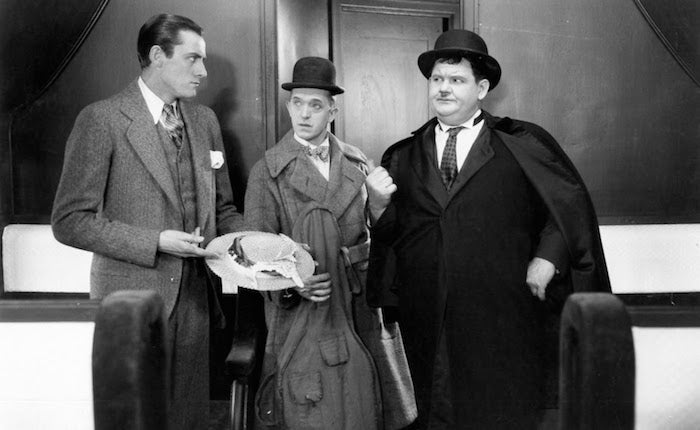
So This is Paris (1926)
As noted in my previous blog, Cinecon Classic Film Festival was held Labor Day weekend at the Egyptian Theatre and the Loews Hollywood Hotel. It was the first Cinecon in 18 years not master-minded by the late president of the organization, Bob Birchard, who passed away in May, and there had been none too few voices predicting the classic film festival’s demise. Happily, a new team under the presidency of Stan Taffel stepped in, and produced a festival that was not only the most successful in years in terms of attendance, but also offered a bit more glitz, including an opening trailer that rivaled anything on TCM, a new logo and new badges. In another break with tradition, Taffel opened the festival by bringing the whole Cinecon team to the front for applause, including Jim Harwood, Bryan Cooper, Michael Schlesinger, Michael Cahill, Sue Kane, Stella Grace and Tobin Larson.
Cinecon opened with the first episode of a serial, Jungle Mystery (dir. Ray Taylor, 1932), and subsequently showed the remaining 11 episodes over the next four days, which is the first time a serial has been screened in its entirety at the festival. Recently preserved by Mike Feinberg at Universal, Jungle Mystery featured B-Western movie star Tom Tyler, Noah Berry Jr., and Cecilia Parker, in an African adventure tale, involving a lost brother and a missing cache of ivory, each episode padded with liberal amounts of stock footage of wild animals, even more stock scenes of various characters running through the jungle, and a script of stock dialogue. Everyone loved it for its camp value.
 Thieves' Highway (1949)
Thieves' Highway (1949)
The first evening continued with William Wellman’s 1934 programmer, Looking For Trouble, starring Spencer Tracy and Jack Oakie as troubleshooting telephone linemen, and Constance Cummings as the suffering fiancé who always gets left behind. With a plot moving a mile a minute and equally swift, wisecracking dialogue, the film was a crowd pleaser to say the least. Oakie would also star in Sitting Pretty (dir. Harry Joe Brown, 1933), a musical comedy about Hollywood’s favorite subject, itself, in this case, two songsmiths (Oakie, Jack Haley) travelling west to work in a fictional film studio. The ménage à trios is completed with Ginger Rogers, who was shooting this film at Paramount at the same time she was completing her breakout role in Flying Down to Rio. As David Sonne reported in his introduction, Oakie was functionally deaf, which makes his singing here all the more remarkable. And we would see Jack Oakie again on Monday in Jules Dassin’s Thieves’ Highway (1949), the last film Dassin completed before being blacklisted. In this film noir, Oakie plays a supporting role as a trucker, while Richard Conte stars as a fruit hauler fighting corruption in the wholesale fresh produce markets, while Valentina Cortese plays the proverbial “whore with a heart of gold,” who redeems him. This film was my personal favorite of the weekend.
Berth Marks (1929)
Then, there was Laurel and Hardy, one program featuring new UCLA restorations of Berth Marks (1929), Come Clean (1931),and the previously unpublished Stan Laurel birthday reel, That’s That (1937), introduced by UCLA preservationist Scott MacQueen. Another program featured The Battle of the Century (1927), with the previously lost second reel, a legendary pie fight to end all pie fights, reunited with the first reel for the first time in almost 90 years, thanks to Jon Marsalis.
As usual, there were plenty of silent films screened over the weekend, beginning with the Universal digital restoration of Paul Leni’s The Last Warning (1929), starring Laura La Plante and Montegu Love. Essentially an old dark house murder mystery, like The Cat and the Canary (1927), but staged in an abandoned theatre, Leni brings all the tricks he learned in Germany making expressionist films to this horror-comedy. More Pay – Less Work (dir. Albert Ray 1926) was a likable but inconsequential comedy about rival shipping company families, starring Mary Brian and Charles “Buddy” Rogers as lovers from opposite sides of the dock. Ramona (dir. Edwin Carewe, 1928), the classic based on Helen Hunt Jackson’s novel, was the feature on Friday night. Another programmer, Diplomacy (dir. Marshall Neilan, 1926) starred Blanche Sweet as a young woman wrongly accused of spying, while her love interest was played by Neil Hamilton. Of greater interest was Michael Curtiz’s second American silent, A Million Bid (1927), starring an absolutely radiant Dolores Costello, as a young girl whose mother sells her off to the highest bidder, even though she loves another.

A Million Bid (1927)
I missed Sky High (Fox, 1922), Robin Hood (Éclair, 1912), The Danger Game (Goldwyn, 1918), Play Safe (Pathé, 1927), with Monty Banks, and In Again, Out Again (John Emerson, 1917) with Douglas Fairbanks. I did see So This is Paris (1926), directed by Ernst Lubitsch, with Patsy Ruth Miller, Monte Blue and Lilyan Tashman. Two couples living across the street from each other get entangled in marital indiscretions; this slimmest of plots is all Lubitsch needs to produce a biting comedy of manners, consisting of windows, doors, and looks, with an anarchic Charleston dance scene thrown in. Not an absolute masterpiece, but certainly the most aesthetically pleasing film of Cinecon 52.
< Back to Archival Spaces blog






 Mobile Navigation
Mobile Navigation

